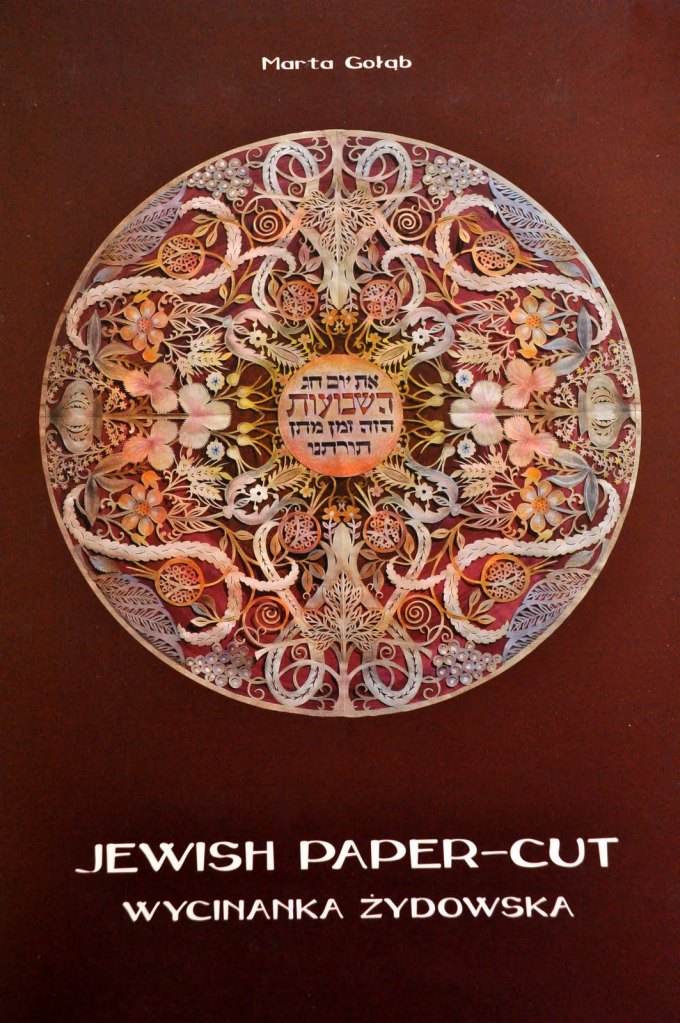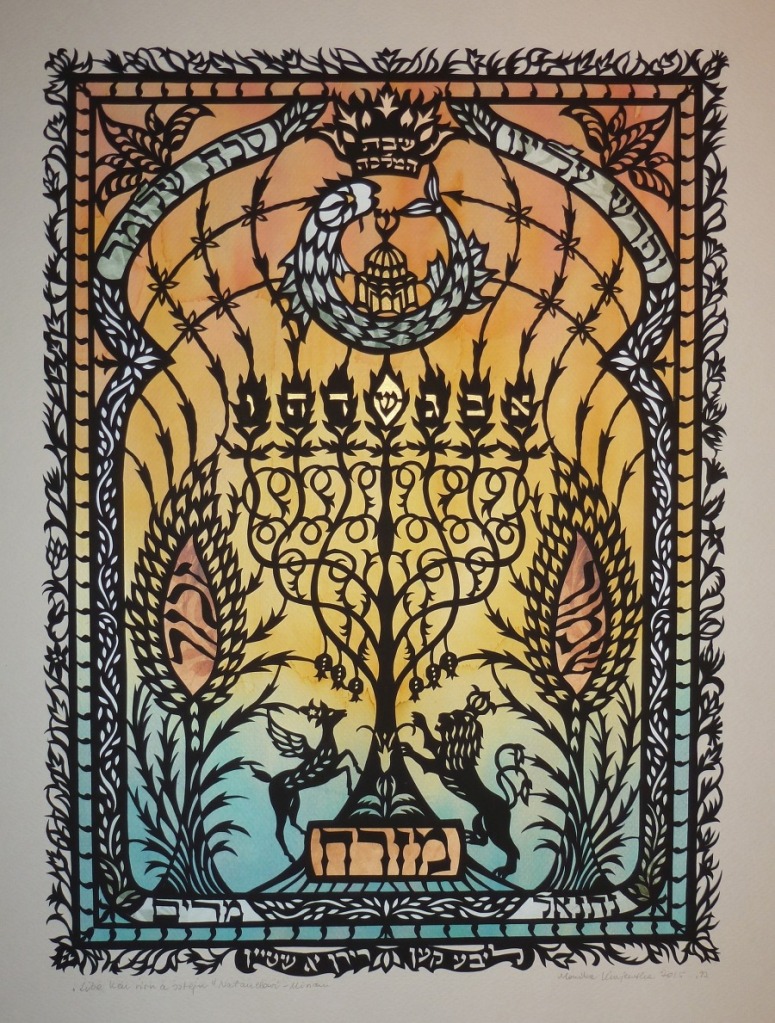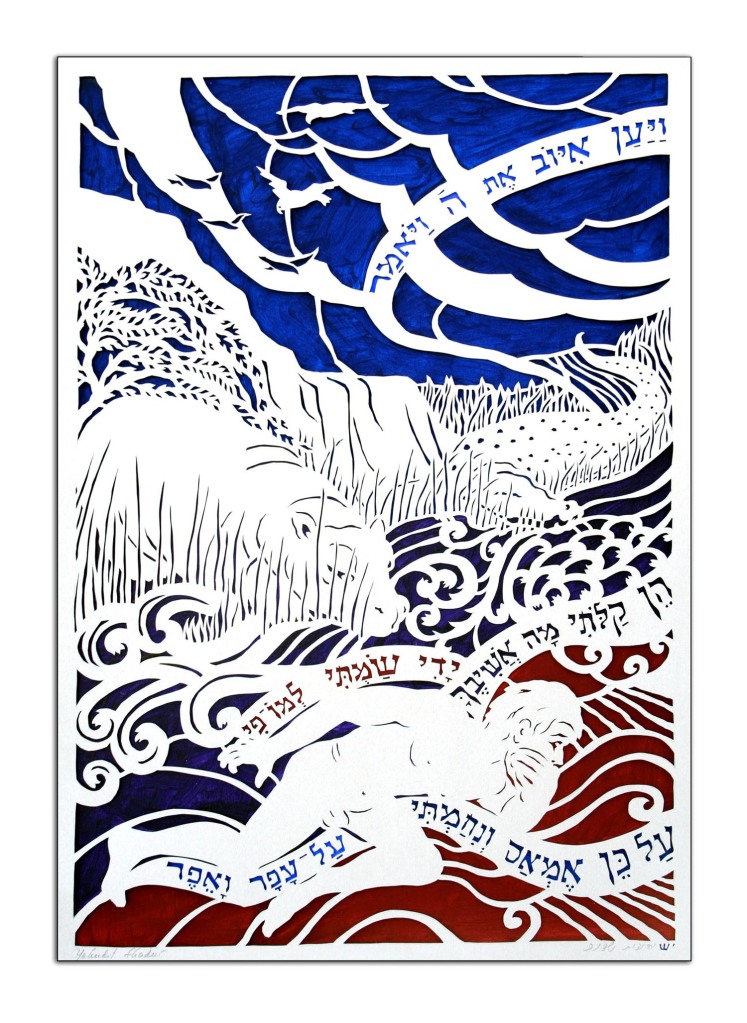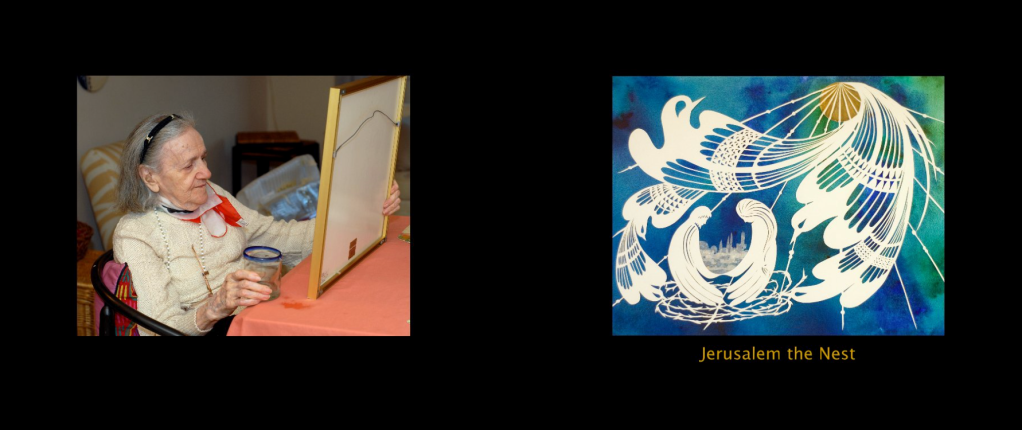No one is certain of how the story of Jewish Paper cutting began. Paper cutting as an art form was started by the Chinese as they were also the creators of paper. Their paper cutting in the only one to be listed in the UNESCO’s Intangible Cultural Heritage List. Similarities between Chinese paper cutters and East European Jewish cutters may point to how it have began as a Jewish folk art.
The first mention of Jewish paper cutting can be found in the treatise “The fight of the pen and the scissors” by a 14th-century Rabbi, Shem Tov ben Isaac ben Ardutiel (1290-1369), who describes how he decided to cut letters in paper when his ink became frozen during a harsh winter. Paper cutting became popular as the materials were cheap and it spread rapidly in Italy, Poland and Jewish Communities in North Africa and the Middle East starting in the 1600’s. (1)
Two particular styles emerged: the Eastern European one called Ashkenazi and the Middle Eastern: Mizrahi. What characterized the Eastern European style is their cutters filled in all empty spaces and the use of the Hamnsa (the five finger hand), while the Middle Eastern preferred simpler symmetrical designs that included menorahs, columns and arabesques. In fact these paper cuts were called a “Menorah” there, because one or more menorah, always appeared as the central motif. These paper cuts included many inscriptions, mostly on the arms of the candelabras.
Here are some beautiful older examples of this beautiful art:

These are Mizrah: ( a plaque that is used to indicate the direction of prayer in Jewish homes, it points towards Jerusalem.)



Jewish paper cutting began disappearing in the first half of the twentieth century, mainly because of the rapid assimilation trends and the waning of many traditional practices, and was practiced only by older people who remembered this art form from their youth. Many paper cuts collections that had been preserved were destroyed during World War II and the Holocaust and relatively few remain in public or private collections.
Fortunately, since the late twentieth century, Jewish paper cuts have again become a popular art form in both Israel and other countries. Paper cutting is again often used to decorate a ketubot (a Jewish marriage contract), wedding invitations, and works of art. Contemporary paper cutting art may also be seen in amulets like hamsas, blessings for the home, and mizrah.
Symbols used
Every element of Jewish paper cut has its own symbolism. Some are typical of general Jewish culture, others are peculiar to the art of paper cutting. The most important symbols are placed along the axis of symmetry.
The main symbols are usually a Torah or a Menorah:
- The image of the Torah symbolizes God’s law, Judaism, Israel. The Star of David symbolizes Judaism and Israel
- The Menorah symbolizes Israel, Judaism, and Temple in Jerusalem. The middle flame is a symbol of ‘Shekinah’ (Hebrew for God’s presence); the other flames are shown as leaning towards the main flame. The bottom of the menorah is often shown as a complicated ornament symbolizing infinity.
A range of animals are depicted in paper cuts:
- Lions, a biblical symbol of the Tribe of Judah, are associated with strength, bravery, power
- Deer symbolize the Tribe of Naphtali
- Birds are associated with the human soul
- Fish are usually connected with fertility
- A squirrel biting a nut symbolizes the effort put into reading the Torah
- The Four Animals (a leopard, an eagle, a gazelle, and a lion) are connected with a sentence from Pirkei Avot: “Be strong as the leopard, swift as the eagle, fleet as the gazelle, and brave as the lion to do the will of your Father in Heaven”
- A snake eating its own tail symbolizes infinity.
Paper cut flora is usually connected with the biblical Tree of Life, with some of the plants having their specific symbolism. For example, vine was associated with the land of Israel and with fertility, pomegranates symbolized fertility, etc. (1)
In Israel, paper cutting was reactivated by Giza Frankel, a Polish-born ethnographer. Frankel’s most significant publications on paper cutting are Wycinanka żydowska w Polsce and Art of the Jewishpaper-cut. Giza Frankel brought knowledge of Polish Jewish paper cuts with her when she emigrated to Israel in 1950. I believe HERE is something that she wrote about it.
These are some of the artists mentioned by Wikipedia and their work:
Marta Gołąb
Marta Gołąb is both a graphic artist and papercutter. Her papercuts were exhibited in the Jewish Museum (Wien) Skirball Cultural Center, (Los Angeles), in Emanu-El Synagogue (San Francisco), in the Synagogue in Grobzig (Germany) and on the Jewish Culture Festival in Krakow.




Monika Krajewska
Monika Krajewska’s interests focused on symbols related both to Jewish papercut and sepulchral art, according to Wycinanka żydowska. She is a member of The Guild of American Papercutters.


This one is so moving:

You can view an online exhibit of her work here: Powerful Papercuts: Online Exhibition of Monika Krajewska’s “Burning” Cycle (2003-2020), a requiem for the Jewish world destroyed in the Shoah.
Yehudit and Joseph Shadur
Yehudit Shadur (1928-2011) grew up in Milwaukee, WI and studied fine art and art history in Milwaukee, London, and New York. In 1950, she settled in Israel, first on kibbutz Nirim in the Negev and later in Jerusalem. For several years she lived and taught at the Sdeh Boqer College of the Negev. Besides her work based on traditional Jewish folk art, she exhibited landscape drawings and has worked in various print-making techniques, mural compositions, and Jewish decorative arts.
Yehudit Shadur and her husband Joseph Shadur wrote various books about Jewish Papercuts. Their book that covered the history of the last three centuries of Jewish paper cutting called: Traditional Jewish Papercuts: An Inner World of Art and Symbol won the 1994 Jewish National Book Council prize. You can preview 64 pages of the 263 pages HERE. It is an amazing book! So well researched!
And HERE is website where you can delight in Yehudit Shadurwork. These are a few photos from it:



And this is a lovely video made with her daughter:
Tsirl Waletzky
Tsirl Waletzky (née Tsirl Grobla) was considered to be a major contemporary paper cutting artist in American Yiddish culture. Waletzky’s papercuts differed from “traditional forms in that they are free flowing and less bound to structure and symmetry.”
This are images from a book about her work being sold at blurb. com:







I aboslutely love this one:

Oren Loloi
Oren Loloi (Papercuts By Oren), is a modern Jewish paper cut artist working in Israel.His work belongs to a new aesthetic that bridges the gap between Jewish tradition and the modern resurgence of paper cutting worldwide. His work mainly focuses on ketubot (marriage contracts). He has also been commissioned by synagogues in New York and Virginia for large scale works.
These are some images form his website. You can visit it HERE.



Well that is all for this post. I hope you enjoyed it! These people have a lot of patience! And my guess very strong fingertips!

Well that is all for this post. I hope you enjoyed it! All these people have something in common… a lot of patience and very strong fingertips!
Credits:
(1) Wikipedia
